Pathological fracture of the femur in Alagille syndrome that was treated with low-intensity pulsed ultrasound stimulation and an Ilizarov ring fixator: a case report
- PMID: 25004954
- PMCID: PMC4109381
- DOI: 10.1186/1471-2474-15-225
Pathological fracture of the femur in Alagille syndrome that was treated with low-intensity pulsed ultrasound stimulation and an Ilizarov ring fixator: a case report
Abstract
Background: Alagille syndrome is a multisystem disorder, which is characterized by hypoplasia of the intrahepatic bile ducts, malformations of the cardiovascular system, eyes, and vertebral column, and abnormal facies. Several of the characteristics of Alagille syndrome may result in an especially high risk of fracture. The majority of patients suffer from chronic cholestasis, which can have a variety of adverse effects on bone metabolism. In Alagille syndrome, fractures primarily occur in the lower limb long bones in the absence of significant trauma.
Case presentation: A 9-year-old Japanese girl with Alagille syndrome was admitted to our institution with marked hyperbilirubinemia and a pathological fracture of the femur. She had been diagnosed with biliary atresia at the age of 1 month and treated with surgical bile duct reconstruction, vitamins D and K, and ursodeoxycholic acid. However, her liver dysfunction and hyperbilirubinemia worsened. The pathological fracture of the femur was treated with low-intensity pulsed ultrasound stimulation (LIPUS) and an Ilizarov ring fixator. Seventy-four days after surgery, the patient had anatomically and functionally recovered. There was no leg-length discrepancy and no angular malalignment of the lower extremities as measured clinically and radiographically. The range of motion of the hip, knee, and ankle of the patient's operative leg matched the range of motion in the nonoperative leg.
Conclusion: To the best of our knowledge, there are no reports on use of the Ilizarov frame and LIPUS in diaphyseal femoral fractures in Alagille syndrome. This case report provides evidence that this procedure is successful for managing such diaphyseal fractures in Alagille syndrome.
Figures
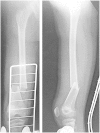
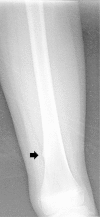

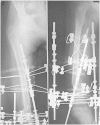
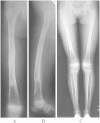
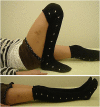
Similar articles
-
Pathological fracture of the femur in Alagille Syndrome: A case report.J Clin Orthop Trauma. 2020 Mar-Apr;11(2):298-301. doi: 10.1016/j.jcot.2019.12.009. Epub 2019 Dec 19. J Clin Orthop Trauma. 2020. PMID: 32099298 Free PMC article.
-
Treatment of open intraarticular distal femur fractures by Ilizarov fixator; an approach to improve the outcome with mid-term results.Injury. 2019 Oct;50(10):1731-1738. doi: 10.1016/j.injury.2019.05.011. Epub 2019 May 21. Injury. 2019. PMID: 31138484
-
A 10-year-old child presenting with syndromic paucity of bile ducts (Alagille syndrome): a case report.J Med Case Rep. 2016 Nov 30;10(1):342. doi: 10.1186/s13256-016-1126-x. J Med Case Rep. 2016. PMID: 27906097 Free PMC article.
-
[Evolution of post-fracture bone deformities in an infant with hepatic osteodystrophy on Alagille syndrome].Rev Chir Orthop Reparatrice Appar Mot. 1998 Jul;84(4):381-6. Rev Chir Orthop Reparatrice Appar Mot. 1998. PMID: 9775042 French.
-
Alagille syndrome.Indian J Pediatr. 2002 Sep;69(9):825-7. doi: 10.1007/BF02723701. Indian J Pediatr. 2002. PMID: 12420920 Review.
Cited by
-
Pathological fracture of the femur in Alagille Syndrome: A case report.J Clin Orthop Trauma. 2020 Mar-Apr;11(2):298-301. doi: 10.1016/j.jcot.2019.12.009. Epub 2019 Dec 19. J Clin Orthop Trauma. 2020. PMID: 32099298 Free PMC article.
-
NOTCH signaling in skeletal progenitors is critical for fracture repair.J Clin Invest. 2016 Apr 1;126(4):1471-81. doi: 10.1172/JCI80672. Epub 2016 Mar 7. J Clin Invest. 2016. PMID: 26950423 Free PMC article.
-
Open tibial shaft fracture in a boy with autism spectrum disorder treated using a ring external fixator: A case report.Trauma Case Rep. 2021 Jun 16;34:100502. doi: 10.1016/j.tcr.2021.100502. eCollection 2021 Aug. Trauma Case Rep. 2021. PMID: 34195342 Free PMC article.
-
Effectiveness of circular hexapod external fixation with soft tissue reconstruction in treating severe knee dislocation due to burn scarring: a case report.BMC Musculoskelet Disord. 2020 Sep 28;21(1):639. doi: 10.1186/s12891-020-03667-7. BMC Musculoskelet Disord. 2020. PMID: 32988378 Free PMC article.
-
The successful treatment of a Gustilo-Anderson type IIIc distal leg injury with a large bone defect in elderly patient with severe osteoporosis: a case report.J Med Case Rep. 2023 Oct 13;17(1):452. doi: 10.1186/s13256-023-04193-5. J Med Case Rep. 2023. PMID: 37828610 Free PMC article.
References
-
- Heritage ML, MacMillan JC, Anderson GJ. DHPLC mutation analysis of Jagged1 (JAG1) reveals six novel mutations in Australian alagille syndrome patients. Hum Mutat. 2002;20(6):481. - PubMed
-
- Emerick KM, Rand EB, Goldmuntz E, Krantz ID, Spinner NB, Piccoli DA. Features of Alagille syndrome in 92 patients: frequency and relation to prognosis. Hepatology. 1999;29(3):822–829. - PubMed
Publication types
MeSH terms
LinkOut - more resources
Full Text Sources
Other Literature Sources
Medical

